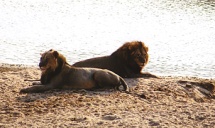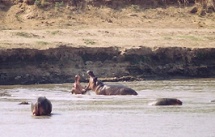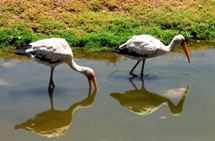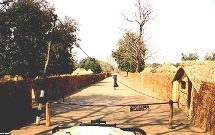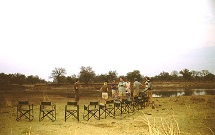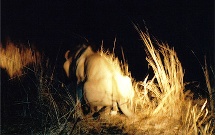Zambia (1): Day Five : Kakuli Bush Camp to Tafika Camp
Today we left Norman Carr Safaris and transferred by road to Tafika Camp which is the home of John and Carol Coppinger (Remote Africa Safaris) – back to (semi) civilisation, as Tafika is their permanent base camp. Since Tafika lies outside the Park, the transfer is by road up to the river bank opposite the camp, followed by a river crossing.
Soon after leaving the camp Alec detected a new bush sound, which he was unable to identify even after switching off the engine. Eventually its provenance was established, and went down in the records as one of the guests' ‘lesser nasal congestion’.
Along the way lion tracks were seen, and followed up to a superb viewing of two magnificent lions by the side of the river (![]() ). Other highlights were hippo having a bit of a scrap (
). Other highlights were hippo having a bit of a scrap (![]() ), lots of buffalo, and a couple of yellow billed storks (
), lots of buffalo, and a couple of yellow billed storks (![]() ). A particular treat was the season’s first recorded warthog piglet – a brave sight with its tail held high, just like a radio aerial.
). A particular treat was the season’s first recorded warthog piglet – a brave sight with its tail held high, just like a radio aerial.
On reaching Tafika, after crossing over the river we were met by Alison who soon whipped up the obligatory Malawi shandies. Tafika (![]() ) is a larger camp, and, after having the remote bush camps to ourselves, it came as something of a shock to share the camp with other guests – some yapping into satellite phones or listening to iPods. Interesting to see that the main form of staff transport within this larger camp took the form of mountain bikes.
) is a larger camp, and, after having the remote bush camps to ourselves, it came as something of a shock to share the camp with other guests – some yapping into satellite phones or listening to iPods. Interesting to see that the main form of staff transport within this larger camp took the form of mountain bikes.
After a Tex-Mex lunch (no lack of variety in the food served on safari) we chose to send emails back home rather than visit the local school, although the latter has proved to be a fascinating experience on previous visits.
At this point we were joined by an American lady, Judith, who we all got on so well with that she remained our travelling companion for the next four days, until our itineraries diverged again.
The afternoon game drive took us back into the Park via a village gate (![]() ) into the Nsefu sector (guided now by Ernst), with several small ellie herds (
) into the Nsefu sector (guided now by Ernst), with several small ellie herds (![]() ), a giraffe caught in the difficult act of drinking (
), a giraffe caught in the difficult act of drinking (![]() ), a light grey mongoose, a tree squirrel (being eyed up by a tawny eagle (
), a light grey mongoose, a tree squirrel (being eyed up by a tawny eagle (![]() ) and carmine bee eaters (
) and carmine bee eaters (![]() ) being the principal offerings.
) being the principal offerings.
Until, that is, we came across two lions that other guests had observed earlier engaged in what lions do in the mating season (every 15 minutes or so, for two to three days, with no thought for any other activity such as eating etc). However the honeymoon couple were obviously too tired to perform for us on this occasion (we gave them five minutes over the fifteen), so we moved on, making a note to return later.
On pulling into a ‘suitable’ spot for sundowners a very pleasant surprise greeted us, in the shape of a champagne buffet laid out in the middle of nowhere (![]() ) (with not a soul in sight – they were hiding down the river bank awaiting our arrival). How civilised Zambia is turning out to be!.
) (with not a soul in sight – they were hiding down the river bank awaiting our arrival). How civilised Zambia is turning out to be!.
After sundowners the champagne had obviously had its effect (somehow) and our mating pair rewarded us with a brief coupling (![]() ), before crashing back into oblivion once more. No foreplay, but she did get a nice cuddle afterwards (“more than I usually get”, remarked one of the (lady) guests, somewhat acidly). Further first time sightings were clocked up in the shape of a marsh mongoose and a bushytailed mongoose.
), before crashing back into oblivion once more. No foreplay, but she did get a nice cuddle afterwards (“more than I usually get”, remarked one of the (lady) guests, somewhat acidly). Further first time sightings were clocked up in the shape of a marsh mongoose and a bushytailed mongoose.
Roast beef for dinner, and a large unknown bug discovered lurking in the hut (![]() ), later identified (via the internet) as an armoured cricket. The wildlife experience was completed by a mouse running around the hut, but once more sleep came readily at the healthy hour of 9.30 p.m.
), later identified (via the internet) as an armoured cricket. The wildlife experience was completed by a mouse running around the hut, but once more sleep came readily at the healthy hour of 9.30 p.m.
This is not to say that said sleep wasn’t disturbed by numerous hippo grazing around the hut.

An interesting moment on another walking mobile safari was the apprehension of a poacher. An indication that poachers were about (in an area in which there should have been no other human beings for miles around) had been the sound of faint gun shots the day before, together with the remains of a zebra, which was missing the whole of one leg and haunch, and the guide explained that poachers would often kill an animal in this way, taking sufficient meat with them for the next day or two.
Close to the remains of the zebra, the guide suddenly spotted a man standing up half a mile or so away (although he was wearing bright clothes he proved very difficult to spot by eyes more keenly attuned to the colours of the bush, and not at all to the shape of a human being).
It turned out that he was just a young boy who had been abandoned by his companions who were in the area (meat) poaching. After a day (and night) alone in the bush he was more than ready to be caught, despite the prison sentence that he then faced. The guide radioed through to an anti-poaching force, who must also have been in the area, and half an hour later, as we watched, the hapless kid was pounced upon from four sides simultaneously, without he or us having noticed a thing.
He was then held in our tented camp overnight, tied to a tree, before a vehicle could be brought up to take him away. This was in fact the most nervous moment of the whole trip – the thought of his (AK47) armed companions returning to rescue him being far scarier than any possible incursion by lion or leopard.
| Back to previous page (Day 4) | Forward to next page (Day 6) |
